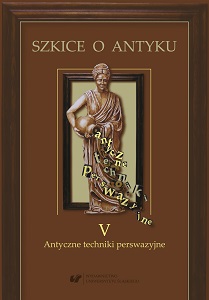Techniki perswazyjne w mowie CyceronaPro Quinto Roscio Comoedo
Persuasive techniques in Cicero’s Pro Quinto Roscio Comoedo
Author(s): Marek Hermann
Subject(s): Philology
Published by: Wydawnictwo Uniwersytetu Śląskiego
Keywords: Plato; Cratylos; ancient etymology; linguistic discourse;
Summary/Abstract: This article considers the instruments of argumentation in Cicero’s speech Pro Quinto Roscio Comoedo based on the rhetorical triad: ethos; pathos and logos. The speech relates to the suit arising from a partnership formed by the famous Roman actor Quintus Roscius and Fannius Cherea. The first device; ethos; is responsible for evoking a favourable reaction in the audience. Cicero draws arguments in this domain from the history of the partnership and Roscius’ character. He shows Roscius as a righteous man; who is worthy of confidence; in contrast to Fannius; who is portrayed as an ugly creature. The second sphere; logos; covers logical means of persuasion: argumenta ad rem; argumenta ad hominem; argumenta e contrario; and subiectiones or syllogisms. These rhetorical instruments influence the minds of listeners in compliance with the demands of logos. The third element; pathos; is used in Cicero’s speech in defence of Roscius to a small extent. The essay examines one more rhetorical device; eikos; which means verisimilar or befitting. This device introduces into the speech significant details that work on several levels to enhance its credibility and emotional impact.
Book: Szkice o antyku T 5. Antyczne techniki perswazyjne.
- Page Range: 63-76
- Page Count: 14
- Publication Year: 2019
- Language: Polish
- Content File-PDF

